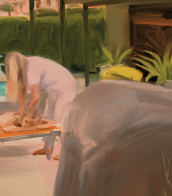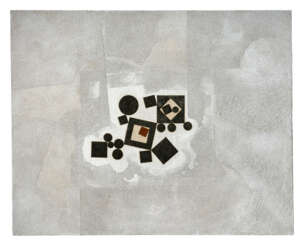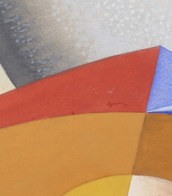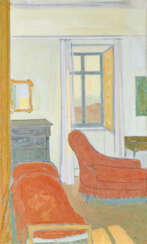francesco d&

Francesco Ubertini Verdi, nicknamed Bacchiacca, was an Italian late Renaissance painter of the Florentine school.
He was born into a creative family: his father was a goldsmith and his brothers were painters. Bacchiacca earned a reputation for his skill as a painter and became the court painter to the dukes, and carried out commissions to paint walls and ceilings for noble Italian families, painting portraits, allegories, altarpieces and images.



Francesco Albani was a renowned Italian painter and fresco artist. He is celebrated for his contributions to the academic Bolognese school, which was profoundly influenced by the Carracci family, under whom Albani trained. Albani's artistic journey began at the young age of 12, marking the start of a career that would see him become one of the 17th-century's most esteemed Bolognese masters.
Francesco Albani's style is characterized by its lyricism and often features cherubic figures, a trait that became his signature. Despite not embracing the monumentality or tenebrism prevalent in the works of his contemporaries, his thematic appeal and mannerist elegance have earned him a place in art history. His works often comprise mythological and religious scenes, executed with a refined and lyrical view of nature. This approach helped disseminate the classical ideals prominent in Carracci's landscapes.
Among Francesco Albani's notable works are his frescoes in the Hall of Aeneas at Palazzo Fava in Bologna and Palazzo Doria Pamphilj in Rome, and his paintings "The Judgment of Paris" and "The Toilet of Venus". His works can be found in prestigious collections worldwide, including the Museo del Prado, Galleria Borghese in Rome, and the Hermitage in St. Petersburg.
Francesco Albani's influence extended beyond his lifetime, with his classicising and idealised scenes finding favor with 18th-century French painters and collectors. However, his popularity waned during the 19th century. Despite this, his work remains an integral part of the study of Baroque art, particularly in understanding the transition from Mannerism to Baroque styles.
For collectors and experts in art and antiques, the legacy of Francesco Albani presents an opportunity to explore a pivotal moment in the history of Italian painting. His works not only provide aesthetic pleasure but also serve as important cultural artifacts, offering insights into the artistic trends and societal values of the 17th century.
If you are passionate about art history and wish to stay informed about new discoveries, sales, and auction events related to Francesco Albani, consider signing up for updates. This subscription will ensure you remain at the forefront of developments in the world of art and antiques, especially concerning this remarkable Italian master.


Giovanni Francesco Barbieri, better known as Guercino, was an Italian Baroque painter and draftsman from Cento in the Emilia region, who was active in Rome and Bologna. The vigorous naturalism of his early manner contrasts with the classical equilibrium of his later works. His many drawings are noted for their luminosity and lively style.


Francesco Solimena was an Italian painter of the seventeenth and eighteenth centuries. He is known as a representative of the Neapolitan school of late Baroque painting. The painter's creativity was highly appreciated by his contemporaries, during his long career he earned a large fortune by selling his works. The artist's biography is closely linked to Naples, the city in which the great genius spent most of his life.
Francesco Solimena was devoted to the religious genre, for which he was often called "Abbot Ciccio" during his lifetime. He educated many famous artists. Solimena's paintings are now in museums in St. Petersburg (Hermitage), London (National Gallery), New York (Metropolitan Museum of Art), Paris (Louvre) and other cities.


Francesco Solimena was an Italian painter of the seventeenth and eighteenth centuries. He is known as a representative of the Neapolitan school of late Baroque painting. The painter's creativity was highly appreciated by his contemporaries, during his long career he earned a large fortune by selling his works. The artist's biography is closely linked to Naples, the city in which the great genius spent most of his life.
Francesco Solimena was devoted to the religious genre, for which he was often called "Abbot Ciccio" during his lifetime. He educated many famous artists. Solimena's paintings are now in museums in St. Petersburg (Hermitage), London (National Gallery), New York (Metropolitan Museum of Art), Paris (Louvre) and other cities.


Francesco Solimena was an Italian painter of the seventeenth and eighteenth centuries. He is known as a representative of the Neapolitan school of late Baroque painting. The painter's creativity was highly appreciated by his contemporaries, during his long career he earned a large fortune by selling his works. The artist's biography is closely linked to Naples, the city in which the great genius spent most of his life.
Francesco Solimena was devoted to the religious genre, for which he was often called "Abbot Ciccio" during his lifetime. He educated many famous artists. Solimena's paintings are now in museums in St. Petersburg (Hermitage), London (National Gallery), New York (Metropolitan Museum of Art), Paris (Louvre) and other cities.


Francesco Menzio was an Italian painter who painted in the Modernist style. Menzio was a member of the Gruppo dei Sei di Torino.


Francesco Solimena was an Italian painter of the seventeenth and eighteenth centuries. He is known as a representative of the Neapolitan school of late Baroque painting. The painter's creativity was highly appreciated by his contemporaries, during his long career he earned a large fortune by selling his works. The artist's biography is closely linked to Naples, the city in which the great genius spent most of his life.
Francesco Solimena was devoted to the religious genre, for which he was often called "Abbot Ciccio" during his lifetime. He educated many famous artists. Solimena's paintings are now in museums in St. Petersburg (Hermitage), London (National Gallery), New York (Metropolitan Museum of Art), Paris (Louvre) and other cities.




Francesco Clemente is an Italian contemporary artist. He has lived at various times in Italy, India and New York City. Some of his work is influenced by the traditional art and culture of India. He has worked in various artistic media including drawing, fresco, graphics, mosaic, oils and sculpture. He was among the principal figures in the Italian Transavanguardia movement of the 1980s, which was characterised by a rejection of Formalism and conceptual art and a return to figurative art and Symbolism.


Francesco Lazzaro Guardi was an Italian painter, nobleman, and a member of the Venetian School. He is considered to be among the last practitioners, along with his brothers, of the classic Venetian school of painting.
In the early part of his career he collaborated with his older brother Gian Antonio in the production of religious paintings. After Gian Antonio's death in 1760, Francesco concentrated on vedute. The earliest of these show the influence of Canaletto, but he gradually adopted a looser style characterized by spirited brush-strokes and freely imagined architecture.


Francesco Lazzaro Guardi was an Italian painter, nobleman, and a member of the Venetian School. He is considered to be among the last practitioners, along with his brothers, of the classic Venetian school of painting.
In the early part of his career he collaborated with his older brother Gian Antonio in the production of religious paintings. After Gian Antonio's death in 1760, Francesco concentrated on vedute. The earliest of these show the influence of Canaletto, but he gradually adopted a looser style characterized by spirited brush-strokes and freely imagined architecture.


Francesco Lazzaro Guardi was an Italian painter, nobleman, and a member of the Venetian School. He is considered to be among the last practitioners, along with his brothers, of the classic Venetian school of painting.
In the early part of his career he collaborated with his older brother Gian Antonio in the production of religious paintings. After Gian Antonio's death in 1760, Francesco concentrated on vedute. The earliest of these show the influence of Canaletto, but he gradually adopted a looser style characterized by spirited brush-strokes and freely imagined architecture.


Francesco Clemente is an Italian contemporary artist. He has lived at various times in Italy, India and New York City. Some of his work is influenced by the traditional art and culture of India. He has worked in various artistic media including drawing, fresco, graphics, mosaic, oils and sculpture. He was among the principal figures in the Italian Transavanguardia movement of the 1980s, which was characterised by a rejection of Formalism and conceptual art and a return to figurative art and Symbolism.


Francesco Clemente is an Italian contemporary artist. He has lived at various times in Italy, India and New York City. Some of his work is influenced by the traditional art and culture of India. He has worked in various artistic media including drawing, fresco, graphics, mosaic, oils and sculpture. He was among the principal figures in the Italian Transavanguardia movement of the 1980s, which was characterised by a rejection of Formalism and conceptual art and a return to figurative art and Symbolism.


Francesco Lazzaro Guardi was an Italian painter, nobleman, and a member of the Venetian School. He is considered to be among the last practitioners, along with his brothers, of the classic Venetian school of painting.
In the early part of his career he collaborated with his older brother Gian Antonio in the production of religious paintings. After Gian Antonio's death in 1760, Francesco concentrated on vedute. The earliest of these show the influence of Canaletto, but he gradually adopted a looser style characterized by spirited brush-strokes and freely imagined architecture.


Francesco di Antonio del Chierico was an early Renaissance Italian painter, illustrator, and jeweler in Florence.
He trained as a goldsmith but later became a highly successful and revered manuscript illustrator. His work was sought after by the patrons of Florence in the second half of the fifteenth century, and he is also considered a favorite artist of Lorenzo de' Medici.
Francesco del Chierico decorated and illustrated books of all sizes that covered a variety of literary, scientific, historical, and religious subjects. He creatively painted manuscript margins as well as full pages. The artist's illustrations often included intricate floral compositions, and he also painted exquisite portraits.


Francesco Clemente is an Italian contemporary artist. He has lived at various times in Italy, India and New York City. Some of his work is influenced by the traditional art and culture of India. He has worked in various artistic media including drawing, fresco, graphics, mosaic, oils and sculpture. He was among the principal figures in the Italian Transavanguardia movement of the 1980s, which was characterised by a rejection of Formalism and conceptual art and a return to figurative art and Symbolism.


Giovanni Francesco Barbieri, better known as Guercino, was an Italian Baroque painter and draftsman from Cento in the Emilia region, who was active in Rome and Bologna. The vigorous naturalism of his early manner contrasts with the classical equilibrium of his later works. His many drawings are noted for their luminosity and lively style.


Pier Francesco Mola, called Il Ticinese, was an Italian painter of the High Baroque, mainly active around Rome.


Giovanni Francesco Barbieri, better known as Guercino, was an Italian Baroque painter and draftsman from Cento in the Emilia region, who was active in Rome and Bologna. The vigorous naturalism of his early manner contrasts with the classical equilibrium of his later works. His many drawings are noted for their luminosity and lively style.


Giovanni Francesco Barbieri, better known as Guercino, was an Italian Baroque painter and draftsman from Cento in the Emilia region, who was active in Rome and Bologna. The vigorous naturalism of his early manner contrasts with the classical equilibrium of his later works. His many drawings are noted for their luminosity and lively style.



































































